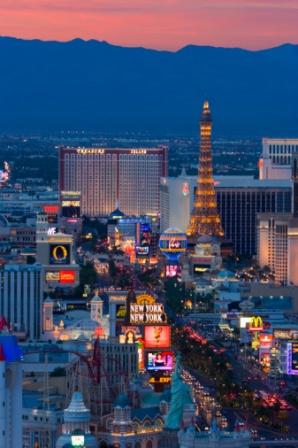

Printable PDF version
Subscribe to our newsletter
Las Vegas Casinos
Two-Tier Markets
The FIDIC Rainbow
Surface Computing
Construction
Management Specialists
111 Pine Street, Suite 1315
San Francisco, CA 94111
(415) 981-9430
www.TBDconsultants.com
Would you like to bet that the next casino to be built in Las Vegas will be smaller than others already there? Probably not. Bigger, more flamboyant, seems to be the order of the day where casinos are concerned.
Of course, they are no just casinos, but entertainment centers, or you could say that that they are enclosed communities, which is what they are designed to make them feel like to the visitor. The El Rancho casino back in 1941 introduced the concept of a lavish setting, and in 1946 the Flamingo was the first to bring entertainment to center stage by adding a showroom. Nowadays, surrounding the gambling hall will be entertainment, bars, restaurants, even shops of various kinds, so the gambler doesn't have to wander far from the gambling floor to meet his or her needs, and wherever they want to go will normally necessitate moving through banks of slot machines, roulette wheels or poker tables. The gaming floor itself may occupy only a relatively small percentage of the floor area, but it is central to casino design, and ideally every path will lead through it. This area of the building will also be central to the design of security and monitoring systems.

The atmosphere of the gambling hall is geared to generate a desire to stay. It has been pointed out that clocks are never seen in a casino, but since almost everybody has a watch, or at least a cellphone or PDA that serves also as a timepiece, nobody can really claim to be unable to determine what the time is if they really want to know. Natural daylighting is one of the goals in the modern move to green buildings, but casinos are unlikely to win any LEED points with that. While more natural daylighting has been getting closer to the gambling hall, it hasn't reached the hall itself yet, and isn't really likely to, because daylight is a ready indicator of passing time. The setting in the casino will give no indication of changes in time; even if the décor depicts an outdoor setting the depicted time of day will remain static. On the other hand, the feel of the place will be anything but static. An aura of excitement is designed into the place, with "loose" slot machines (ones that pay off frequently and noisily) strategically placed to entice people into the excitement of it all, and free drinks and snacks brought to you so you feel less need to leave.

In 1966, the opening of Caesars Palace set the trend for a consistent theme, which has continued to this day. A walk down the Strip is a combined world tour with time travel and side-trips into fantasyland thrown in for good measure. The hotels/casinos have become forms of entertainment themselves, with theming being as important a part of the architecture as they are in a Disneyland exhibit.
Casinos are designed for round-the-clock operation, never shutting down. The construction site for a new casino is going to be similarly designed. Casinos generate large revenues, allowing for high construction budgets, but also leading to a desire for getting into operation as early as possible, so fast-tracking the design and construction is the norm on these projects.
Subprime became the word-of-the-year for 2007, and for good reason. What does the collapse of the housing market portend for the construction industry in the coming year?
If you are involved in international construction, you will inevitably come across the FIDIC form of contract. But there is a range of FIDIC contracts, not just one. Here we look at the range of FIDIC contracts, in all their hues.
Geoff’s
IT Gems
Surface
Computing
The next big thing in computers is coming to a coffee table near you! Horizontal screen and collaboration is at the heart of this latest innovation from Microsoft.
Design consultant: Katie Levine of Vallance, Inc.